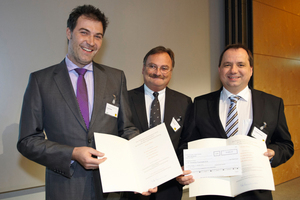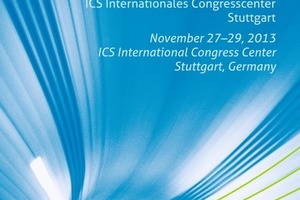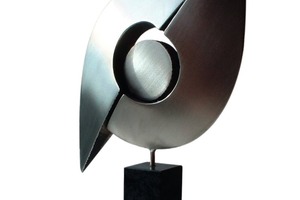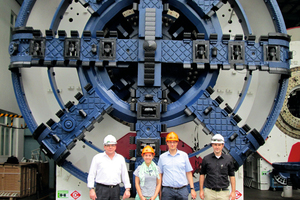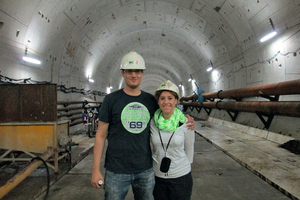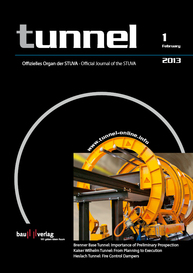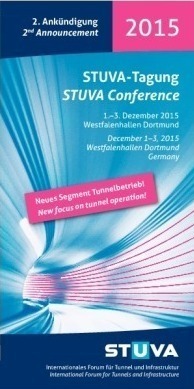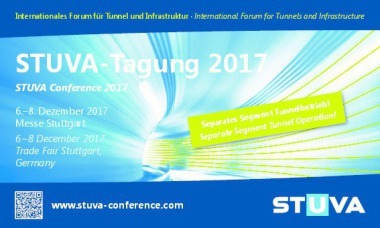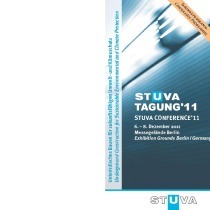STUVA news
STUVA Staffer Dr.-Ing. Dirk Boenke awarded the 2012 Traffic Safety Prize
Dr.-Ing. Dirk Boenke, head of STUVA’s Traffic + Environment section, was awarded the Traffic Safety Prize presented by the Federal Ministry for Transport, Building and Urban Development at the 8th ADAC/BASt Symposium on “Driving safely in Europe” in Baden-Baden/D. Together with his team Boenke took first place among a total of 5 prize-winning projects. The Traffic Safety Prize is awarded every 2 to 3 years. It marks pioneering, application-oriented research and development projects designed to improve road traffic safety (Fig. 1).
Under the direction of the Leibnitz Institute for Work Research at Dortmund TU (IfADo) Dr. Sebastian Poschadel (project management), Dr. Dirk Boenke, Dr. Anke Blöbaum and Silke Rabczinski undertook a study based on a control group of how the driving skills of elderly people could be trained in actual traffic situations. It was demonstrated that the driving skills of drivers aged over 70 can be enhanced in the long term thanks to training in actual traffic. Training enabled them to perform at a level commensurate with middle-aged drivers.
During the study a driving instructor accompanied the candidates when practising tricky situations actually encountered in road traffic (complex crossings, turning left). The effect of this training remained stable over the duration of a year. The results of the project indicate that growing old does not necessary lead to people being precluded from participating in motoring. During training drivers in excess of 70 years of age were able to raise their game to perform at a level reached by younger motorists (average age of 44). Some surprises were also revealed by the results: good older drivers needed only a few hours of practice with the driving instructor to demonstrate they had benefitted from training. As far as really proficient older drivers are concerned their skills can only be marginally improved if at all. At the same time it was revealed that poor drivers particularly benefit from training. The greatest effect was displayed by those older motorists, whose driving skills were limited at the beginning of the study and who went through the entire training programme.
Age-related regulations for driving licences and in turn the conflict surrounding safeguarding mobility at a ripe old age are ongoing talking points in our society. Driving training as well as feed-back on driving in actual traffic conditions affords the opportunity to extend the driving skills of older motorists in terms of time and as a result retain individual mobility and participation in society. In this connection the result of the project, which supports the concept of developing the driving capabilities of older motorists, is also politically significant.
The research project was sponsored financially by the Eugen-Otto-Butz Foundation. The complete research report is available from the TÜV-Verlag in the series “Mobilität und Alter” from the Eugen-Otto-Butz Foundation under the title: “Older Motorists: Maintaining, Improving and Extending Driving Skills through Training”. A summary can be downloaded from the IfADo by accessing //www.ifado.de/profil/Mit" target="_blank" >www.ifado.de/profil/Mit:http://www.ifado.de/profil/Mitarbeiter/Poschadel/Index.php
2013 STUVA Conference
For more than 45 years the STUVA Conference has represented one of the most important platforms for the entire spectrum of underground construction. With around 1,500 participants from as many as 30 countries, it is one of the world’s leading and biggest events on the tunnelling sector. The STUVA Conference takes place every 2 years at the end of November/beginning of December in uneven years. On the first and second day at the Conference experts from the tunnelling branch present around 35 to 40 papers. On Day 3, participants are invited to take part in excursions involving interesting sites and installations for transportation facilities in the region (Fig. 2).
The next STUVA Conference will be held From November 27 to 29, 2013 at the ICS Internal Congress Center Stuttgart.
The Conference will concentrate on:
“Tunnels – Infrastructure for the Future”
Efficient infrastructures are essential for the future development and prosperity of a country. They represent the key towards a well functioning economy and the prerequisite for ensuring that regions participate in global market in future as well. However mobility is more than intrinsically important for a flourishing economy, it is also numbered among mankind’s basic needs.
This has been recognised throughout Europe nowadays as a significant socio-political goal. Common guidelines were established by the European Parliament in 1996 for example for developing the trans-European transportation networks (TEN). The “Stuttgart 21” construction scheme is part of a project classified as enjoying priority within these guidelines. Against this background and on account of the construction measures already undertaken there, Stuttgart was selected as the venue for the 2013 STUVA Conference.
Seen on a worldwide basis, a well functioning infrastructure fulfils an even greater role: the world’s population is increasing by around 80 million per year. In 2015 roughly 10 % of the urban population will live in megacities with more than 15 million inhabitants. The growing need for mobility can to a large extent only be accomplished through underground transportation facilities on account of the limited space available.
Relocating transportation for carrying people and goods under the surface represents improving mobility. However use of the subsurface also enhances the quality of life on the surface considerably. Areas, which have become free thanks to redevelopment measures, furthermore afford new perspectives for sustainable urban development. For instance as a result of the Stuttgart ’21 project more than 100 hectares of prime space will become available, which will be used for 11,000 new dwellings, thousands of permanent workplaces and for extending the Schlossgarten.
Consequently underground construction enjoys outstanding importance from the viewpoint of sustainability particularly in cities, urban conurbations and topographically tricky areas.
Against this background, papers will be presented relating to the following major topics:
Tunnelling in tricky ground, current technical developments on all sectors of underground construction
International major projects
Planning, construction, maintenance, redevelopment, retrofitting, research
Safety during construction and operation of tunnels
Future-oriented topics in tunnelling such as e.g. producing new utility routes as well as producing and utilising energy during the construction and operation of tunnels
Economy, contract design, financing; planning and approval processes, involvement of citizens in major projects.
With a few exceptions, STUVA members are permitted to present a paper at the STUVA Conference. The call for papers was sent out to the members of the STUVA Inc. in mid-December 2012 in preparation for the open series of presentations on November 27 and 28, 2013.
Details on the Conference are available by accessing //www.stuva-conference.de" target="_blank" >www.stuva-conference.de:www.stuva-conference.de. The Conference programme with the registration documents is due to be sent at the end of May 2013.
The members’ tariff will only be granted to employees of STUVA member companies. Any unjustified claims will be correspondingly redressed. Member companies, registering more than 15 participants, will receive an additional 10 % reduction on the Conference fee as from the 16th participant.
Exhibition
An exhibition will accompany the series of papers. Traditionally in excess of 140 companies from home and abroad are expected to display their products and services relating to foundation engineering and tunnelling on more than 5,000 m² of exhibition space. Through this combination of STUVA Conference and Exhibition participants are provided with a unique platform for exchanging views on all sectors of underground construction with national and international experts coming together. At the time of going to press more than 900 m² of net exhibition space had been sold. Get in touch with //www.stuva-expo.de" target="_blank" >www.stuva-expo.de:www.stuva-expo.de to discover how to take part as exhibitor.
STUVA Prize
The Research Association for Underground Transportation Facilities Inc. – STUVA – will award the STUVA Prize ’13 on the occasion of the 2013 STUVA Conference in Stuttgart for outstanding innovations in the field of underground construction (Fig. 3).
In 1996 the STUVA Board decided to introduce a “STUVA Prize” for outstanding innovations in the field of underground construction to promote the concept of the utilisation of underground space among experts and the general public. The prize in the form of a sculpture has been awarded every 2 years since 1097 at a STUVA Conference. The sculpture was created particularly for this purpose by a leading artist.
The award is made to persons whose work is regarded as a particularly outstanding innovation in the field of underground construction and relevant neighbouring sectors. This includes all specialised areas of underground construction such as planning, execution, operation, safety issues, environmental protection, theory, experimental activities, economy, financing and marketing. In addition, lifetime achievements of persons, who have distinguished themselves in tunnelling and underground construction as well as future-oriented projects, can be considered for the award.
Past prize-winners:
1997 Ltd. Baudirektor Rolf Bielecki
1999 Dipl-.Ing. Claus Becker
2001 Prof. Wolfgang Brameshuber
2003 NEAT Project, Switzerland
2005 Dr.-Ing. E. h. Martin Herrenknecht
2007 Betuwe Route Project, Netherlands
2009 Prof. E.h. Heinz Duddeck
2011 Citybanan Project, Stockholm
A candidate can put forward his own application or be proposed by a third party.
The STUVA Inc. office requires the following:
Presentation of the innovation, its practical application and its effects or presentation of the outstanding significance of the person for underground construction (max. 10 pp. with supplementary photo material)
Details of the originator of the innovation or details applying to the person (short CV)
The jury comprises the STUVA Board:
Dipl.-Ing. Wolfgang Feldwisch
Prof. E.h. Günter Girnau (honorary board member)
Dr.-Ing. Karl Morgen (1st deputy chairman)
Dipl.-Ing. Otto Schließler (2nd deputy chairman)
Dipl.-Ing. Edgar Schömig
Prof. Martin Ziegler (chairman)
External experts can be drafted in as required. Recourse to legal action is precluded.
Closing date for applications is July 31, 2013.
STUVA Young Scientist Prize 2011 – Travel Report
Within the scope of the 2011 STUVA Conference Dipl.-Ing. Anna-Lena Hammer (née Wiese), chair for tunnelling, pipeline construction and construction management, Ruhr University Bochum, won the prize in the “Young Forum” for her paper on “Comparative Investigations of compressive Elements for Application in Squeezing Rock”. The decision came about based on an assessment by the audience attending the series of lectures with points awarded for content, the nature of pictorial presentation and the manner of presentation. Anna-Lena Hammer (née Wiese) was able to impress in every category. The prize consisted of a trip to China taking in outstanding tunnel construction sites and production facilities for tunnel boring machines. In the meantime she has been able to accept the prize undertaking the journey as a young bride with her husband Lutz Hammer. An account of their experiences follows.
The trip organised by the STUVA and Herrenknecht led through China – from Shanghai via Guangzhou to Nanjing – and afforded an interesting insight into current tunnelling projects. In addition to impressive construction sites, visits were paid to the Herrenknecht plants at Shanghai and Guangzhou.
The need for an efficient transportation infrastructure is increasing alongside China’s enormous economic progress. The ever growing mega-cities in China basically lack the opportunities for development “on the surface”. The natural thing to do is to exploit underground space for the necessary infrastructural adjustments for transportation. Tunnelling is currently befitting from this situation. Numerous tunnel projects whether in terms of Metro construction or other technical advancements in transportation are currently being built or are at least planned.
Upon arriving in Shanghai it became evident that the existing infrastructure is unable to cope with the extremely high volume of traffic. The road from the airport to the Herrenknecht Shanghai Tunnelling (HST) facility could only be undertaken at a snail’s pace accompanied by loud blaring of car horns.
After a tour of the plant and inspecting an EPB shield set up for acceptance, the construction site was next on the agenda. The 6.78 km long Hong Mei Road Tunnel crossing below the Huangpu River is intended to link the blossoming city with its outer suburbs. The tunnel has been under excavation since June 2012 using a Mixshield with 14.9 m diameter.
The country, people and nature came under scrutiny the next day as impressions arrived thick and fast. The OrientalPearl Tower completed in 1995, at 486 m the world’s fifth largest TV tower, and China’s tallest building for a long time, can be regarded as symbolic for the rapid economic upswing experienced at the time.
The view from a glass platform shows the complete dimension of a fast growing urban landscape. Now surrounded by numerous skyscrapers it is difficult to discern where the city tails off. The many gardens such as the Yu-YuanGarden dating back to 1559, which also houses an historic shopping district, afford opportunities to relax in this pulsating metropolis. The traditional tranquillity of China reveals itself in the middle of a fast moving city.
Guangzhou was the second destination on the trip, China’s third-largest city and an important industrial and commercial centre (Fig. 4).
Rainer Hirsch, managing-director of Herrenknecht Tunnelling (HTM), reported on the numerous construction projects as well as providing an interesting insight into Herrenknecht’s organisational structure in Asia. This was followed by a traditional Cantonese lunch and a visit to the CantonTower, at 600 m – the world’s second tallest TV tower.
Nanjing, one of the oldest cities in the south of China, represented the final highlight on the STUVA trip. A new Metro route is currently being built here, Line 10. The 3.6 km long tunnel is being driven by means of a Herrenknecht Mixshield with 11.61 m diameter. At the time of the visit, the machine was being retooled so that Anna-Lena and Lutz Hammer had the chance to explore every sector of the excavation (Fig. 5).
After the construction site, the next focal point was Nanjing’s old city wall dating back to the Ming Dynasty. Traditional dishes from the south Chinese region were tried out in the thriving district around the Confucius Temple with its lively shopping and entertainment facilities.
Anna-Lena and Lutz Hammer felt that the trip they had undertaken was “incredibly exciting, instructive and above all, highly interesting”. A country such as China, which is growing so rapidly, is especially of interest for a tunneller.

